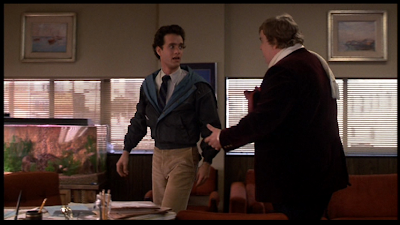
Bluebells and poppies are easily identifiable, and other flowers are plaited, clumped in clusters, coiled like roses and balls of colour. A starburst flower is like a giant sun, a lacy, frayed flower looks indistuingishable from the real thing, whilst also resembling la sea sponge or anemone. It’s like nature magnified, complete with perching bumblebees. Others are more obviously stylised, with buttons for centres. The flowers are cartoonishly real - gaps are knitted into the pattern where the veins of the leaves would be, thread winds through the blooms like filaments, tiny clear beads glisten like a trail of dew and silvery embroidery trails across leaves. It's sort of a pop art take on flowers, remade in wool, shiny, fluffy and multicoloured. When you get closer, you realise it's knitting, but not as you've seen it before. It's more alive, somehow, than any of the other works in the room. This artwork almost dances through the air, fragile tendrils twisting against the pane of glass in the door.

It appears to be a window box or plant pot on the floor, from which are climbing tens of flowers in every colour you can think of, with reds and fluorescent yellows and oranges leaping out. This seemed to bury the ghost of Ms Chirwa however, the court then concluded that "f however the pleadings, properly interpreted, establish that the applicant is asserting a claim under the LRA, one that is to be determined exclu- sively by the Labour Court, the High Court would lack jurisdiction".Your eye, however, is drawn to something incongruous, over by the door. It does not mean that all other remedies which might lie in other courts like the High Court and Equality Court, can no longer be adjudicated by those courts." 86 Ultimately, jurisdiction is determined on the pleadings and not on the substantive merits of a case. Where the judgment of Ngcobo J in Chirwa speaks of a court for labour and employment disputes, it refers to labour- and employment related disputes for which the LRA creates specific remedies.

Where a remedy lies in the High Court, section 157(2) cannot be read to mean that it no longer lies there and should not be read to mean as much. As far as contractual disputes are concerned the court held that: "Furthermore, the LRA does not intend to destroy causes of action or remedies and section 157 should not be interpreted to do so. Accordingly, section 157(1) should be given an expansive interpretation to protect the special status of the labour court, and section 157(2) should not be read to permit the high court to have jurisdiction over these matters as well.' The latter section must rather be interpreted to mean that the labour court will be able to determine constitutional issues which arise before it, in the specific jurisdictional areas which have been created for it by the act. The court read section 157(1) as confirming that the labour court has exclu- sive jurisdiction over any matter that the act prescribes should be determined by it, which includes, inter alia, reviews of the decisions of the CCMA under section 145 of the act.

The court therefore stated that forum shopping is not desirable and that once a litigant has chosen a particular course of action, the litigant is married to that course for bet- ter or for worse.18 As far as the high court's jurisdiction based on the Promotion of Administrative Justice Act was concerned, the court neatly came to the conclusion that if there is no administrative action, the issue of overlapping jurisdiction will not be raised.184 The court then continued to state that where the state acts as employer and its action has little or no effect on the public, it will not constitute administrative action.

TOWARDS SOCIAL JUSTICE: AN ELUSIVE AND A CHALLENGING ENDEAVOUR liberty to relegate the finely-tuned dispute resolution structures of the Labour Rela- tions Act, a dual system of law could fester in cases of dismissal of employees.


 0 kommentar(er)
0 kommentar(er)
